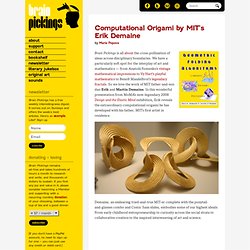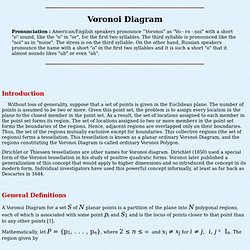

Benoit Mandelbrot: Fractals and the art of roughness. Erik Demaine's Computational Origami. By Maria Popova Brain Pickings is all about the cross-pollination of ideas across disciplinary boundaries.

We have a particularly soft spot for the interplay of art and mathematics — from Anatolii Fomenko’s vintage mathematical impressions to Vy Hart’s playful mathematics to Benoît Mandelbrot’s legendary fractals. So we love the work of MIT father-and-son duo Erik and Martin Demaine. In this wonderful presentation from MoMA’s now-legendary 2008 Design and the Elastic Mind exhibition, Erik reveals the extraordinary computational origami he has developed with his father, MIT’s first artist in residence. Demaine, an endearing tried-and-true MIT-er complete with the ponytail-and-glasses combo and Comic Sans slides, embodies some of our highest ideals: From early childhood entrepreneurship to curiosity across the social strata to collaborative creation to the inspired interweaving of art and science.
Brain Pickings has a free weekly newsletter and people say it’s cool. Share on Tumblr. The Voronoi Game Page. Voronoi Diagram. Pronunciation : American/English speakers pronounce “Voronoi” as "Vo - ro - noi" with a short "o" sound, like the "o" in "or", for the first two syllables.

The third syllable is pronounced like the "noi" as in "noise". The stress is on the third syllable. On the other hand, Russian speakers pronounce the name with a short "o" in the first two syllables and it is such a short "o" that it almost sounds likes "uh" or even "ah". Introduction Without loss of generality, suppose that a set of points is given in the Euclidean plane. Dirichlet or Thiessen tessellations are other names for Voronoi diagram. General Definitions A Voronoi Diagram for a set S of N planar points is a partition of the plane into N polygonal regions, each of which is associated with some point pi and S1 and is the locus of points closer to that point than to any other points [1]. Mathematically, let P = {p1, . . . , pn}, where 2 ≤ n ≤ ∞ and xi ≠ xj for i ≠ j, i, j In. V(pi) = {x: || x - xi || ≤ || x - xj || for j ≠ i, i. The Official M.C. Escher Website.
COMPLEXITY GRAPHICS. CHAOS AND STRUCTURE on the Behance Network. Project MUSE - Leonardo - Model Ideas: From Stem Cell Simulation to Floating Art Work. Five Manifestos for the Creative Life. By Kirstin Butler How a numbered list can start a personal revolution.

Some days everyone needs a little extra encouragement. The words or lines or colors don’t want to come, or worse, we don’t even want to sit down to create. That’s when we turn to these inspiring manifestos, any one of which is guaranteed to give our uncooperative creativity a sharp kick in the pants. Here are five of our favorite contemporary manifestos that nudge ideas out of your head and into the hands of the world. We’ve long been fans of the amazing work of Frederick Terral, the creative visionary behind design studio Right Brain Terrain. You may not be a Picasso or Mozart but you don’t have to be. We can’t imagine more sound advice. Guidelines to get you from Point A to finished product, The Cult of Done Manifesto was written by tech guru Bre Pettis (of MakerBot fame) in collaboration with writer Kio Stark in 20 minutes, “because we only had 20 minutes to get it done.”
This is your life. There is an enemy.